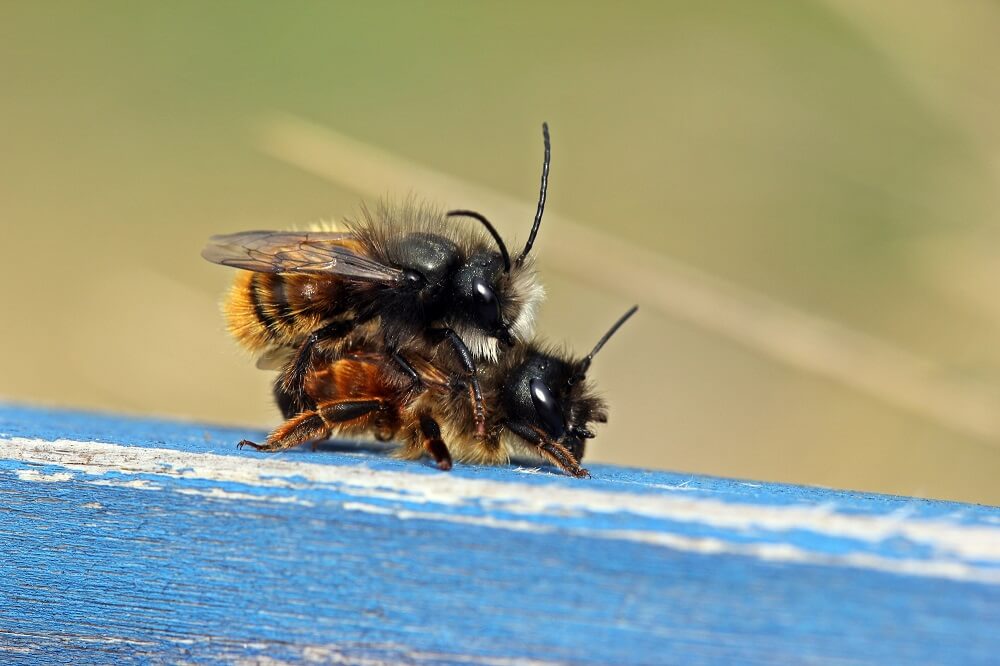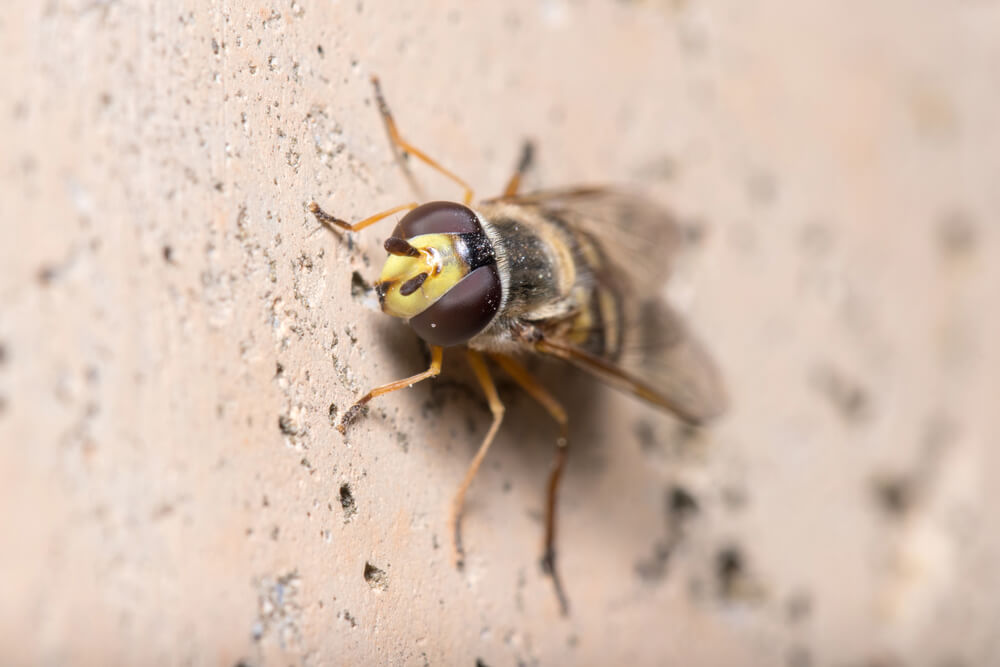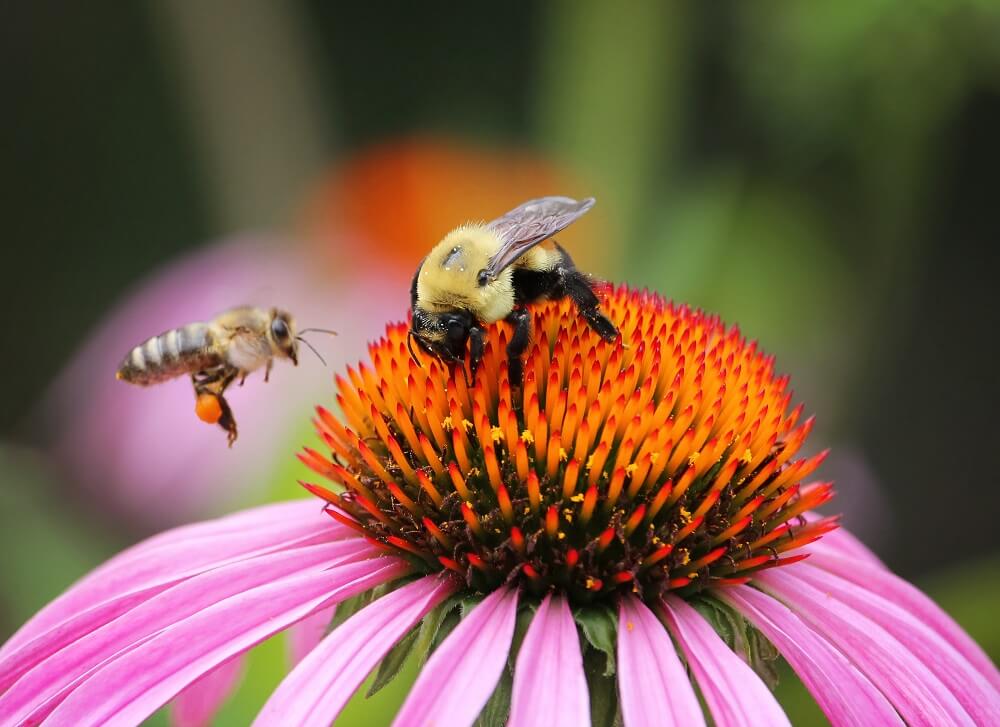Table of Contents:
How Do Bees Reproduce?
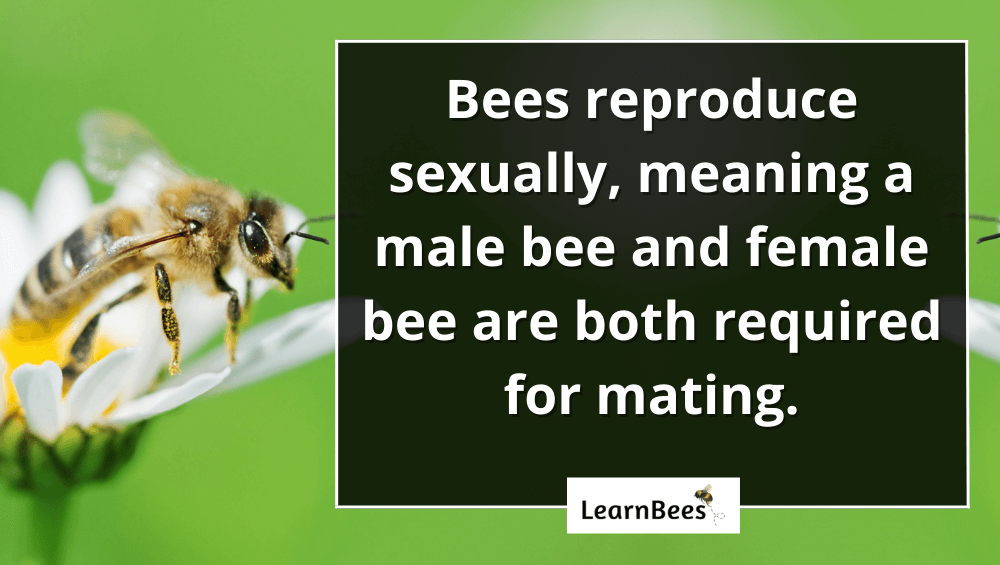
Here’s the thing:
There are more than 20,000 bee species around the world.(1)
Honeybees, bumblebees, and carpenter bees are common bee species examples. With that in mind, mating habits vary amongst different bee species.
But they all share one thing in common:
Bees reproduce sexually, meaning a male bee and a female bee are required for mating.
With that said, we get asked a lot about honeybee and bumblebee reproduction. So let’s talk about both.
How Do Honey Bees Reproduce?
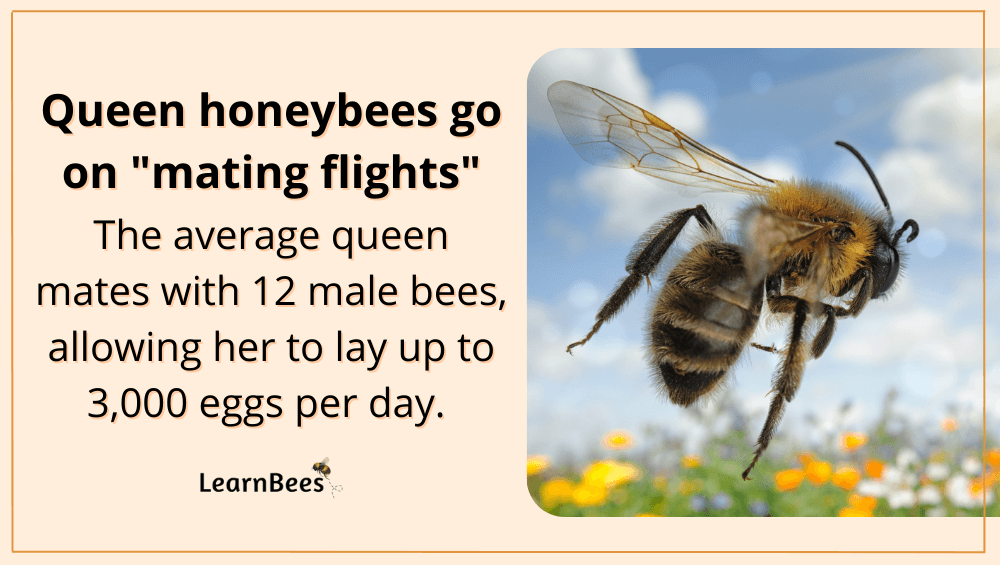
Simply put:
The queen honeybee goes on a ‘mating flight’ where she leaves her hive to find male bees from other hives. These male bees are called drones, and their sole purpose is to mate with queens.
How do they do it?
It all starts in the spring or summer. During this time, hundreds of drones huddle together to form a ‘drone congregation area.’
The male bees buzz loudly and cluster together to attract the queen’s attention. Once she arrives, mating takes place mid-flight.
But don’t get me wrong.
Not all male bees get a chance to mate with the queen. Competition is fierce, and drones have to be fast. So out of hundreds of male bees, only 10-35 of them will get the chance to mate with the queen.(2)
Take a look at this video showing honeybee mating:
The queen can take multiple mating flights, with each flight lasting up to 30 minutes.(3, 4)
But once the process is complete?
The queen never mates again.
After undergoing a few mating flights, the queen collects enough sperm to lay eggs for the rest of her life. Her mating duty is over for good.
And let me say this:
Honeybee colonies are massive compared to other bee colonies.
They can contain anywhere from 10,000 to 60,000 honeybees in a single hive. Compare that to bumblebee colonies which only contain 50-400 bumblebees.
Huge difference.
This means that the queen honeybee is busy at work laying eggs. In fact, a healthy queen honeybee can lay up to 3,000 eggs per day.(5)
Why does she lay so many?
Because honeybee colonies lose an average of 1,000 worker honeybees per day. And since worker bee lifespans are short, the queen has to work hard to replace them. This prevents the honeybee hive population from dipping too low.
How Do Bumble Bees Reproduce?
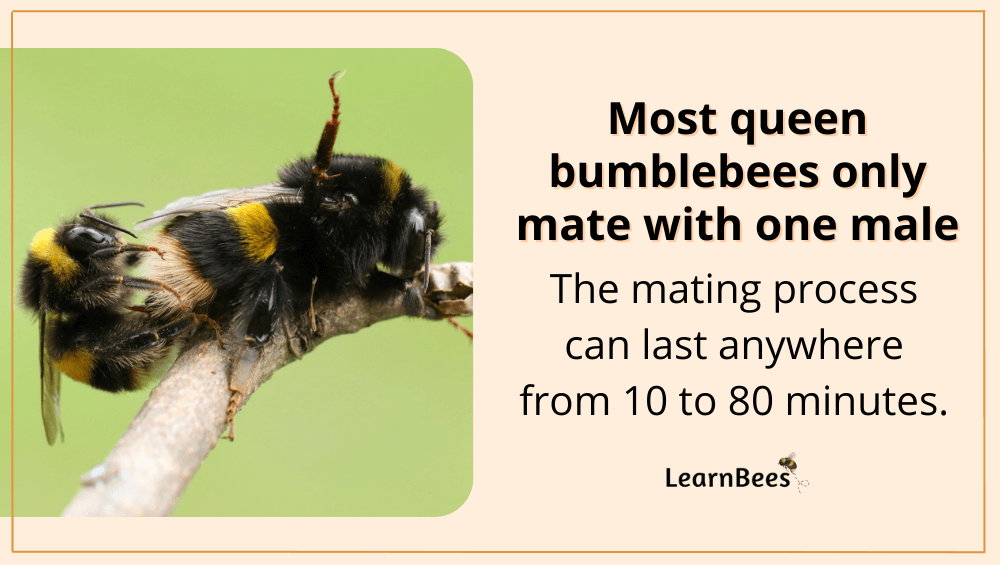
Honeybees and bumblebees share this in common:
Only the queen bee gets to mate.
And as for the rest of the mating habits between bumblebees and honeybees?
They’re quite different.
For starters, most queen bumblebees only mate with one male. She finds him because he “baits” an area with pheromones that attract her.
And unlike honeybees, bumblebee mating typically occurs on the ground. This is because it takes longer than a few seconds for bumblebees to mate. In fact, mating can last anywhere from 10 to 80 minutes.
Here’s a video of bumblebees reproducing:
Why does it last so long?
Because the pair gets ‘stuck’ together.
The male bumblebee holds onto the queen to ensure his genes are being passed on. And since male bumblebees typically only mate once, he doesn’t want to spoil his single chance.
As a result, this gives the queen bumblebee enough sperm to lay eggs for the rest of her life.
But here’s the thing:
Queen bumblebees don’t live nearly as long as queen honeybees do. Bumblebee colonies are annual, meaning they only live up to one year.
Contrastly, queen honeybees can live two to four years.
Do Male Bees Die After Reproducing?

You might be surprised to learn that most male bee species don’t die after mating.
Male bumblebees, carpenter bees, and mason bees are a few examples of male bees that survive the reproduction process. In other words, they can safely mate with many different females if they have the opportunity.
As for male honeybees?
They aren’t so lucky.
Male honeybees (drones) die after mating because their endophallus gets stuck inside the queen. Once the drone pulls away, his endophallus gets ripped out of his body. The loss of this vital organ leads to his death.
So, in short:
Male honeybees die immediately after mating. But most other male bee species do not.
Can Worker Bees Reproduce?
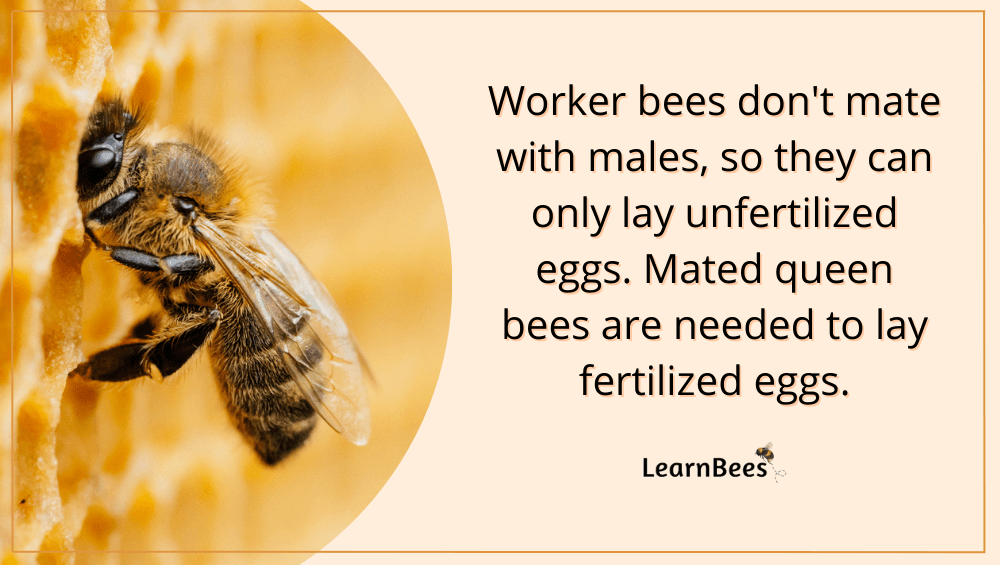
Yes and no.
Worker bees can lay eggs. But worker bees can only lay unfertilized eggs because they don’t mate like queen bees do. Unfertilized eggs result in male bees.
Why is this a problem?
For starters, colonies need both male and female bees to survive. So a hive full of unfertilized eggs leads to a hive full of male bees.
And here’s the thing:
Male bees can’t produce honey, nor can they care for young bees or the queen. Male bees can’t even protect the hive because they don’t have stingers.
A male bee’s sole job is to mate with a queen.
In contrast, female worker bees are responsible for feeding, protecting, and growing the nest. Without them, the colony would fail.
This is where the queen comes in.
Queen bees lay both fertilized (female) and unfertilized (male) eggs. This is because she’s the only bee that mates with males and collects sperm. As such, the future of the colony depends on her.
FAQs on “How Do Bees Reproduce?”
- When is bee mating season?
- How do honey bees reproduce sexually?
- How do honey bees reproduce asexually?
- Why do worker bees not reproduce?
- Do bees need males to reproduce?
- Why do bees mate?
- Do bees mate outside the hive?
- How many eggs does a queen bee lay?
- How often do bees reproduce?
- How do solitary bees reproduce?
When is bee mating season?
Bees mate during the spring and summer. Bees are only active in warm weather, so they don’t mate during the winter.
Bumblebee queens, for example, hibernate throughout the cold months. They emerge in the spring when temperatures start to rise.
Honeybee queens don’t hibernate. Instead, they remain huddled together with their colony of bees. This keeps them warm, so they don’t freeze when temperatures drop.
—> Go back to the FAQs on “How Do Bees Reproduce?”
More to Explore:
How do honey bees reproduce sexually?
People often ask numerous questions such as:
How do bees multiply? How do bees mate? How does a bee get pregnant? Does a queen bee mate? How do queen bees reproduce? How do bees procreate?
The queen honeybee goes on a “mating flight.”
During mating season, many male bees gather together in a “drone congregation area.” This big group of buzzing male bees catches the queen’s attention.
Next, the queen flies near the drone congregation area and mates with 10-20 drones. Afterward, the drones die, and the queen returns to the hive. The queen stores the sperm from these matings in her sperm sac, which allows her to lay fertilized eggs for the rest of her life.
—> Go back to the FAQs on “How Do Bees Reproduce?”
More to Explore:
How do honey bees reproduce asexually?
The short answer?
They don’t. Most honeybee species reproduce sexually, meaning they need both males and females to do the job. That said, there is one exception of honeybees in South Africa that can reproduce asexually.(6)
But, most honeybee species reproduce sexually. They depend on a mated queen bee to lay fertilized eggs. In contrast, worker bees can only lay unfertilized eggs.
And this is a problem because unfertilized eggs result in male bees, which don’t perform work around the hive. Male bees have one job: to mate with queens. Male bees don’t make honey, care for young bees, or protect the hive.
So a hive full of unfertilized (male) eggs is in trouble. The colony needs both female and male bees to survive. Female bees are responsible for a large part of the work for the hive. Hence why female bees are called “worker bees.”
—> Go back to the FAQs on “How Do Bees Reproduce?”
More to Explore:
Why do worker bees not reproduce?
Bee colonies are like well-oiled machines. Every bee has a role that they’re happy to perform.
For example, drone bees are responsible for mating with queens. Queens are responsible for laying eggs that hatch into drones and worker bees. Worker bees are responsible for collecting food, cleaning the hive, protecting the hive, and taking care of the other bees.
Worker bees don’t reproduce because it’s not their job. They never mate with male bees; therefore, they can never produce fertilized eggs.
The unfertilized egg of a honey bee develops into drone (male) bees. Worker bees can only lay unfertilized eggs, which would result in a hive full of male bees. Such a hive would fail because female worker bees are necessary for collecting food, water, cleaning, and protecting the colony.
Male bees don’t do the duties that female worker bees do. They simply just focus on mating with queens.
—> Go back to the FAQs on “How Do Bees Reproduce?”
More to Explore:
Do bees need males to reproduce?
Yes, bees need males to reproduce because they’d only produce unfertilized eggs without them.
And people often ask, “Can bees lay eggs without mating?”
Yes, worker bees can lay eggs without mating. However, these eggs are unfertilized and result in male bees. With that in mind, a colony can’t survive unless it has both male and female bees.
—> Go back to the FAQs on “How Do Bees Reproduce?”
More to Explore:
Why do bees mate?
To put it simply:
Bees mate to ensure the future generation of bees. Male bees mate with the queen so she can lay fertilized eggs. Queen bees lay two types of eggs: fertilized eggs and unfertilized eggs.
Fertilized eggs become female worker bees, while unfertilized eggs become male drone bees.
As mentioned, this process happens so the colony can produce more bees. Worker bees don’t mate because their role is to work for the hive, not to reproduce.
—> Go back to the FAQs on “How Do Bees Reproduce?”
More to Explore:
- Ground Bees: Are They a Threat to Your Yard?
- Wasps vs. Honeybees: Are They Different?
- Do Bumble Bees Bite?
Do bees mate outside the hive?
People frequently ask, “How do bees mate with the queen?”
In most cases, bees mate outside the hive. The process starts with the queen flying out of the hive to look for male bees.
With that said:
The mating process differs amongst bee species.
For example, queen honeybees mate with several males in flight to ensure that she collects enough sperm to last the rest of her life. She can mate with 10-34 drones during this process.
Other bees, like bumblebees, typically only mate with one male. And unlike honeybees, bumblebees usually mate on the ground instead of in midflight.
After the queen mates, she stores the sperm in her sperm sac until she’s ready to lay eggs.
—> Go back to the FAQs on “How Do Bees Reproduce?”
More to Explore:
How many eggs does a queen bee lay? How fast do bees reproduce?
It depends on the species of bee. There are thousands of bee species, including bumblebees, honeybees, and mason bees.
Queen honeybees, for example, lay lots of eggs compared to other types of bees. More specifically, they can lay up to 3,000 eggs per day.
Other bee species don’t lay as many eggs. For example, mason bees are solitary bees that lay only one to two eggs per day.
Queen honeybees lay so many eggs because honeybee hives are large. They can contain between 10,000 to 60,000 honeybees. Compare that to bumblebee hives, which only have 50 – 400 bees.
—> Go back to the FAQs on “How Do Bees Reproduce?”
More to Explore:
- Do Carpenter Bees Pollinate?
- How Long Do Bumble Bees Live?
- Honeybees vs. Bumblebees: How Do They Compare?
How often do bees reproduce? How long do bees reproduce?
Most species of bees only mate once. This provides them with enough sperm to lay eggs for the rest of their lifetime.
That said, queen honeybees mate several times over a few days. After this process is complete, she never mates again and has enough sperm to lay eggs for the rest of her life.
—> Go back to the FAQs on “How Do Bees Reproduce?”
More to Explore:
How do solitary bees reproduce?
People regularly ask questions like:
How do carpenter bees reproduce? How do mason bees reproduce? How do leafcutter bees reproduce? How do ground bees reproduce?
As mentioned, there are thousands of different bee species. Each has unique mating habits that vary slightly from species to species.
For example, queen bumblebees hatch in late summer and mate with a male bumblebee. Once cooler weather arrives, the queen bumblebees go into hibernation. Finally, they emerge in the spring to lay eggs and start their own colony.
On the other hand, female mason bees hatch in the early spring and mate soon after. Carpenter bees also mate in the spring.
So, in a nutshell:
Different types of bees have unique mating habits.
